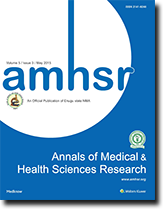

Background: Because of the widespread prevalence of the various cutaneous mycoses in a tropical country like India, it is important to know their patterns of etiology and clinical presentations. Aim: The present study was conducted in order to identify the clinical pattern of various cutaneous mycoses and the common etiological agents affecting the study populations admitted in SMS Hospital, Jaipur, in North India. Materials and Methods: Skin scrapings and hair and nail samples of 160 patients with clinical suspicion of dermatophytosis were collected and subjected to direct microscopy and were cultured in Sabouraud’s dextrose agar. Fungal species were identified by macroscopic and microscopic examination. Data were presented as simple descriptive statistics (SPSS, Version 17.0 (Chicago Il, USA). Epi Info Version 3.5.1 (CDC, Atlanta, Georgia, USA). Results: Among the 160 clinically suspected patients of cutaneous mycoses, 60 (37.5%) were confirmed by culture. Dermatophytes and nonâ�?�?�?�?dermatophytes (NDM) were isolated from 66.6% (40/60) and 33.3% (20/60) of the positive cultures, respectively. Tinea capitis (50%) 30/60 was the most frequent clinical pattern and genus Trichophyton violaceum 32.5% (13/40) was the most common isolate in dermatophytosisâ�?�?�?�?positive samples. Among the patients positive for NDM by culture, Tinea unguium 35% (7/20) was the most common clinical presentation and Aspergillus species 40% (8/20) were the most common etiological agents isolated. Conclusion: Although dermatophtes have been isolated from the cases of cutaneous mycoses all over the world with various frequencies, the role of NDM in the different cutaneous infections other than those of nail infections need to be evaluated.
Select your language of interest to view the total content in your interested language
Annals of Medical and Health Sciences Research received 24805 citations as per google scholar report
 The Annals of Medical and Health Sciences Research is a monthly multidisciplinary medical journal.
The Annals of Medical and Health Sciences Research is a monthly multidisciplinary medical journal.